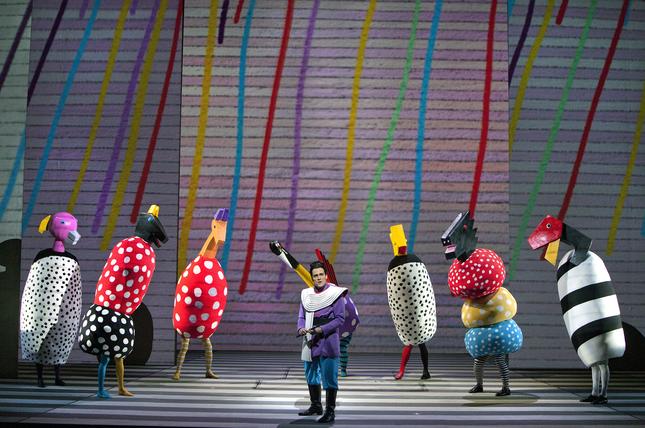Kaneko’s Art Energizes WNO’s ‘Magic Flute’
By • October 28, 2014 0 1449

The day after I saw the Washington National Opera production of Mozart’s “The Magic Flute” at the Kennedy Center’s Opera House, I ran into a neighbor of mine who has a daughter in first grade, a precocious and restless youngster. I suggested that he should he take her to the production, all but guaranteeing that she would like it.
This comes by way of noting that there were a lot of children of a similar age in attendance at the opening night performance and more during the “Opera in the Outfield” simulcast at Nationals Stadium.
Mozart’s “Flute” was, to a large degree. sourced from 18th-century fairy tale collections and must have seemed then, as it is today, an almost ideal way of introducing young audiences to the world of opera. Certainly, this production is in line with artistic director Francesca Zambello’s endeavors to stage more works for young audiences—we’ve already seen two Christmas productions in that arena, and now the “The Magic Flute” with “The Little Prince” scheduled for next season.
It’s entirely likely that the presence of young children in the audience—much as they might have same effect in “The Nutcracker”—added a measure of fresh energy to the enjoyment of the production for adults.
Still, given that this is Mozart’s last opera, with the still-young genius operating at full musical variety throttle, the added frisson of a youthful presence is a little like an extra glass of champagne.
In this production, in which the digital designs, projections and sets and costumes of noted ceramic artist Jun Kaneko, provide a kinetic engine for the opera as well as a truly magical background and foreground, there’s a lot of added value for adults to become enthralled by. Not only is Kaneko’s work a kind of visual magic flute in action, there’s the fact that the opera is sung and spoken in English, making it more accessible for all of the audience, with NSO dramaturge Kelly O’Rourke bypassing potentially treacherous pitfalls and temptations in her adaptation.
And, of course, there’s Mozart and the music, with a composition so rich in diverse motifs and moods, genres, moods and mastery. It’s almost a glossary of everything you can experience in opera. Listening to some of the familiar music, the traditional opportunities and challenges provided for singers, the wayward joys and shocks throughout, it makes you almost sick to think that this was Mozart’s last work. He died at 35 with half a lifetime of work still ahead.
This production does the work honor in many ways—the originality of the translation, the hyper never-seen-that-before quality of Kaneko’s work, the singing and the orchestra work all combine to reveal what’s always there, the true collaborative quality of opera, and how designers, singers, performers, and musicians can create what is essentially and literally a spell binder.
You can just imagine this in the hands of Richard Wagner, although it’s probably fair to say he never had much truck for children on stage, or perhaps under foot, either. Still, as a story, this is a quest tale—a young prince named Tamino, eager for life experience, is tasked with the rescue of a princess whom he falls in love with immediately. He’s been asked to sally forth and find the princess by her mother, the Queen of the Night, and brings along a spirited, down-to-earth sidekick named Papageno. The princess Pamino is supposedly in the hands of the evil sorcerer Sarastro. Tamino must find wisdom, truth, courage and strength along the way, passing, as heroes do, several tests. He must learn to see what’s true and ask questions—there’s a reason mom is queen of the night as opposed to queen of the daytime.
There is a dragon, a fool and a secret order. There is danger and spirits who float by in airy balloons. There is danger and romance and comedy tonight, mostly provided by the chatty Papageno.
Mostly, there are some wonderful performances, in particular by Canadian baritone Joshua Hopkins as Papageno, whose singing and acting are straightforward. He’s the lovable buffoon with a song in his heart. American soprano Kathryn Lewek as the Queen of the Night, gives glamour to being wicked and thrills to her vocalizing, with two of the most difficult and sweep-away, jump-out-of-your-seat arias ever composed, which she nails in bravura style. American bass and local favorite Soloman Howard again displays his lower range in moving fashion, making everything rich with intonation. American soprano Maureen McKay, slight in stature but mighty in a voice full of romantic yearning, makes an appealing heroine, who’s matched by Canadian tenor Joseph Kaiser’s steadfast and earnest hero Tamino.
This is a production for which the specific glues are Mozart and Kaneko. During the overture we’re treated to almost an illustration of the music by projections that look and feel like uncharacteristically frisky Mondrian paintings trying to escape their graphs, responding to something celestial and emotional. The projections are seen—and in a way heard—throughout, providing another element.
The words, too, are worthy of listening to. Some of the spoken asides are witty and right now, without debasing the content for its own sake, including a complaint about the constant chattering heard in the world.
This version of “The Magic Flute” in the end is seductive. It invites and encourages being seduced and diving in. When a depressed Pagegano momentarily considers suicide, he was encouraged by an audience member to “do it.”
This may not happen in succeeding performances. But something will—you just watch and listen.

